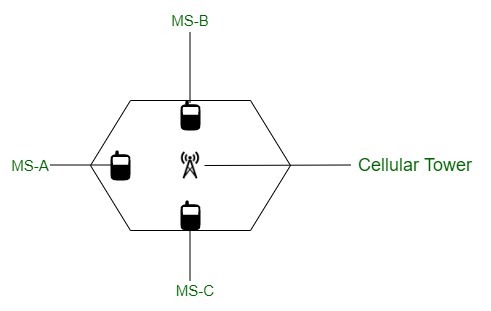Difference between Cellular and Ad hoc network
Last Updated :
06 Jul, 2022
1. Ad hoc Network :
An ad hoc network is a network that is composed of individual devices communicating with each other directly. The term implies spontaneous or impromptu construction because these networks often bypass the gatekeeping hardware or central access point such as a router. Many ad hoc networks are local area networks where computers or other devices are enabled to send data directly to one another rather than going through a centralized access point.

2. Cellular Network :
A Cellular network or Mobile network is a radio network distributed over land areas called cells, each served by at least one fixed-location transceiver, known as a cell site or base station. At present sent cell remote systems, for example, GSM/CDMA/HSPA/LTE are foundation type. Cell organize comprises of focal element known as base station and cell phones as Mobile Subscribers(MS). In the event that MS-A needs to speak with MS-B, correspondence happens by means of base station(BTS) as appeared in the figure. It follows hexagonal pattern.

Let’s see that the difference between Cellular Network and Ad hoc Network :
| S.NO |
Cellular Network |
Ad hoc Network |
| 1. |
The network routing of cellular network are centralized, all the traffic goes through the base station. |
The network routing of adhoc network are distributed, no centralized system such as base station needed. |
| 2. |
Circuit Switching are used. |
Packet Switching are used. |
| 3. |
It has single hop type. |
It has multiple hopes |
| 4. |
Star topology are used. |
Mesh topology are used. |
| 5. |
It takes Higher cost and takes more time for deployment. |
It takes lower cost and does not take more time for deployment. |
| 6. |
It is used in Designed and developed for voice traffic. |
It is used in Designed to meet best effort data traffic requirements. |
| 7. |
Here Low call drops during mobility due to seamless connectivity across region. |
Here higher breaks in the path during mobility. |
| 8. |
It requires periodic maintenance so it is costly. |
Here nodes are self-organizing and hence it is less costly. |
| 9. |
The allocation bandwidth is guaranteed and easy. |
The allocation of bandwidth is based on shared channel using complex MAC algorithms. |
| 10. |
IS-95, IS-136, GSM, Mobile WiMAX, CDMA, LTE technologies are used. |
WLAN 802.11e technology are used. |
| 11. |
Frequency spectrum is reused through geographical channels. |
Dynamic frequency reuse through carrier sense mechanism. |
Like Article
Suggest improvement
Share your thoughts in the comments
Please Login to comment...